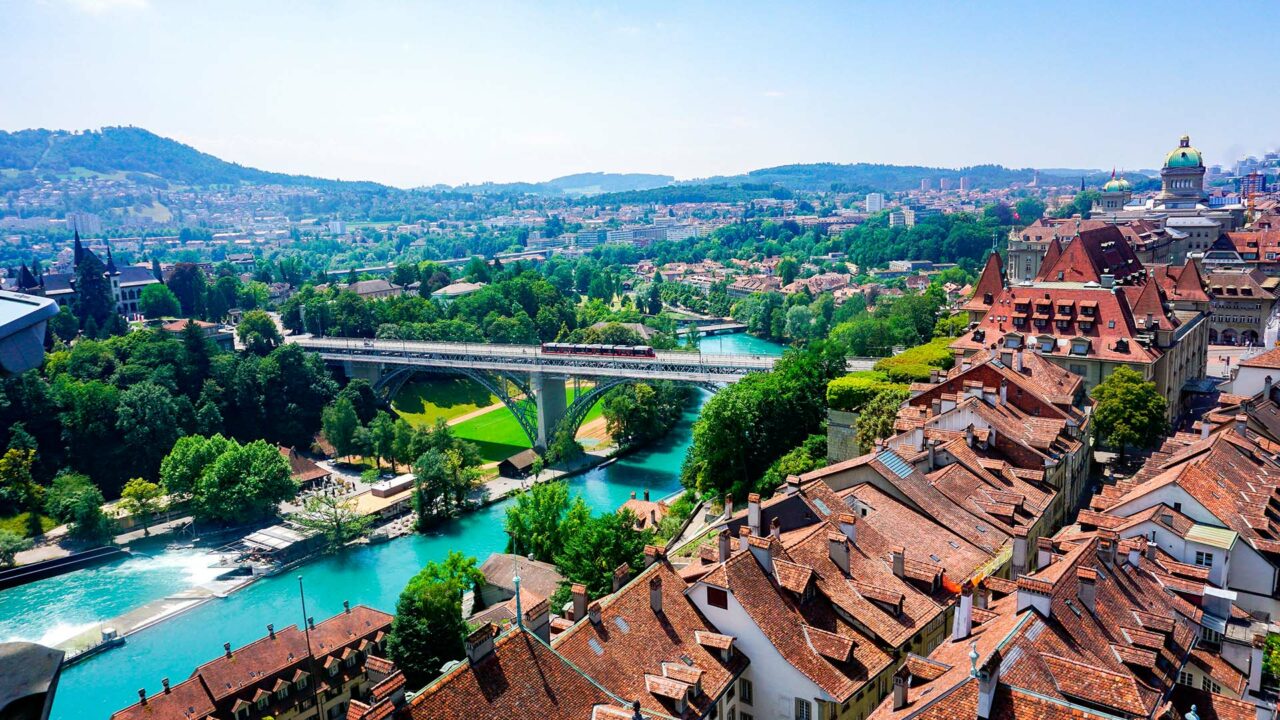The tracks are surrounded by snow, two black, parallel lines fading into white, crossing through silent forests and past steep, rocky slopes. Below, valleys push their way through the mountains: some narrow and cramped, others wide and deep. The carriages of the Green Train of the Alps, an old-fashioned railroad line that connects Italy’s Domodossola to Switzerland’s Bern, treat travelers to a stunning route — especially during the Christmas season — between the sunny terraces of the Valais and the mountains of the Bernese Oberland.
The journey takes just over two hours to reach the heart of Switzerland’s capital, whose Old Town is among the UNESCO World Heritage Sites. But it can take longer if you make intermediate stops, such as the one at Lake Oeschinen. It makes steep climbs over mountain edges and plunges into deep tunnels. These include the 19.8 kms (12.3 miles) of the Simplon Tunnel, which has linked Italy and Switzerland for more than a hundred years since its opening in 1906.
Once the pass is reached, the railway line offers views south to the Driest and Aletsch glaciers and north to Stockalper Castle.
From here it climbs further up the Rhone Valley, reaching Goppenstein to eventually enter the Lötschen Valley. Lötschberger is the Austrian name for this train, which not only has become an inimitable tourist attraction but is also the still-living symbol of engineering feats of yesteryear, when the pioneers of great works tested themselves with challenges never seen before.
The railway linking Italy and Switzerland was built at the beginning of the 20th century, more than a hundred years ago, a great work employing some 3,000 workers, mostly Italians who went to live with their families in Naters, Goppenstein, Frutigen and Kandersteg to get closer to the construction sites.
Together they all took part in the construction of this railway line, which was also accompanied by work on the Simplon Tunnel, characterised by particularly complex passages such as the “northern ramp,” or a climb with a gradient of 27% where the line passes through a spiral tunnel almost 2 km (1.2 miles) long. From here, the line runs over the spectacular Kander Viaduct, one of the best known in the world precisely because of its height, until it makes the final stretch from the Alpine village of Thun to Bern.

The world's other most beautiful train trips
The emotions experienced aboard the Green Train of the Alps are a taste of what to expect when traveling along the world’s most spectacular rail lines that blend engineering and excitement, the work of the human hand and the traveler’s passion for discovery.
Forests, glaciers, deserts, precipitous viaducts, interminable tunnels – some of the rail lines built to connect cities and countries and thus bring development to otherwise unexplored territories have put the skills of civil engineering to the test.
Take for example the Nice-Digne line in France, a breathtaking run through the heights of Provence that is 151 km (93 miles) long and marked by 16 viaducts, 15 metal bridges and 27 tunnels. The train is known the world over as “Train of the Pinecones,” precisely because the line’s route passes through many pine forests – although during World War II, the story goes that train drivers used pinecones as fuel to run the train because of the coal shortage.
Another unique line connects the highlands of Madagascar to its coast, running between the cities of Fianarantsoa and Manakara. Just 160 kms (99 miles) that take about 12 hours to travel because of the train’s reduced speed and its many stops. This train stands out for its age: the line was built between 1926 and 1936, but some of the cars in the convoy date as far back as 1890.
On the other side of the world, in Brazil, another train line defies gravity. It is the Curitiba-Paranaguà line, in all over 100 kms (62 miles) of winding track through Brazil’s dense forest, and crossing the Serra do Mar mountains. This line is also very old, dating back to 1880. Thousands of men worked on its construction and many lost their lives due to tropical diseases and the era’s dangerous working conditions. Today it has become a landmark for tourists and adventure enthusiasts.
The train that crosses the Australian Outback is an almost endless journey that takes about 26 hours and therefore may not be for everyone. The convoy runs twice a week and offers a unique experience for travelers intent on experiencing the secret of the Australian desert. It is a 1,325 kilomete (823-mile) journey from Brisbane to Longreach on a modern line that opened in 1993 specifically to take travelers where they could never go before. The ultimate meaning of great rail lines.

